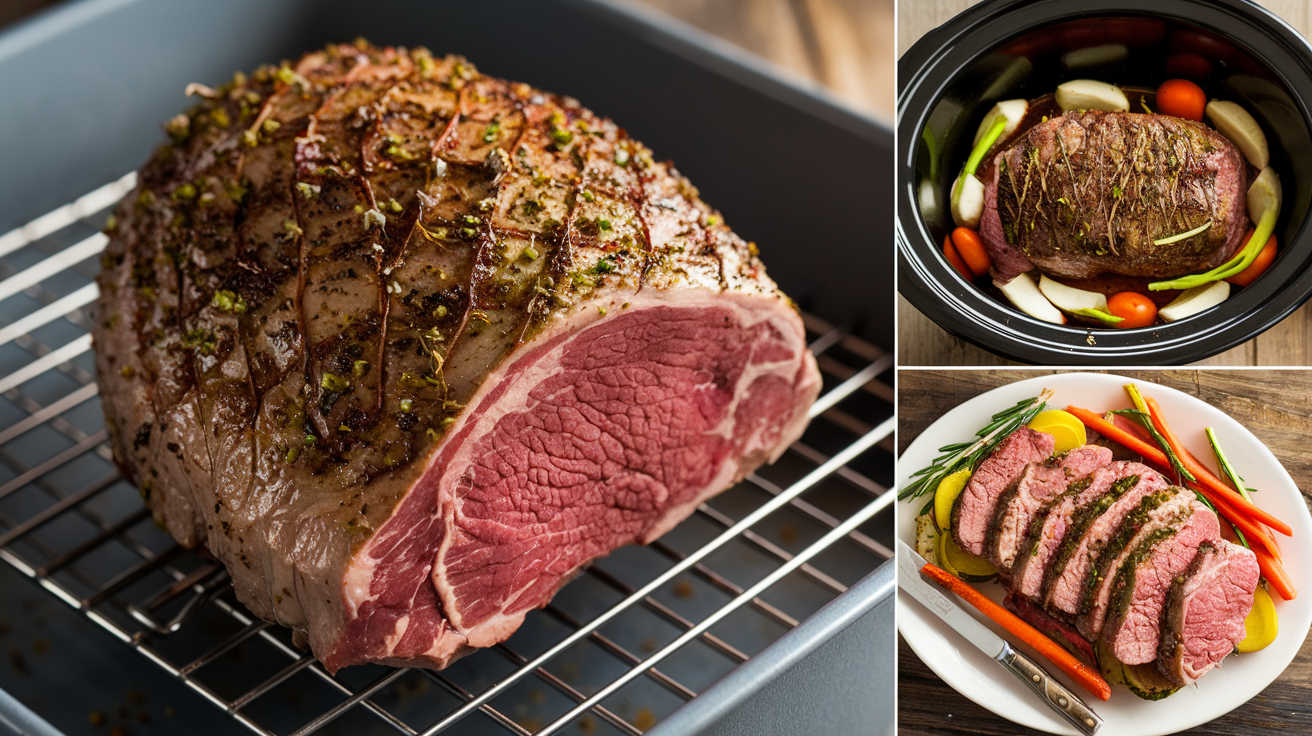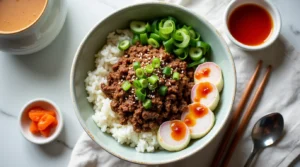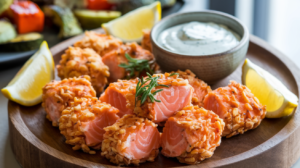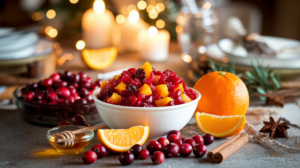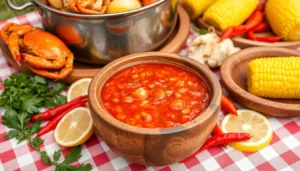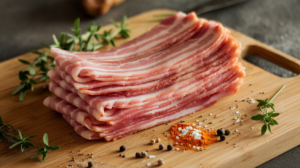Bottom Round Roast Recipe: Easy Steps for Perfectly Tender Roast
Bottom Round Roast Recipe: Easy Steps for Perfectly Tender Roast
- Looking for a delicious and hearty beef recipe that’s perfect for family dinners or special occasions? This bottom round roast recipe is a game-changer! Known for its affordability and robust flavor, the bottom round roast may seem tough at first glance, but with the right cooking methods, it transforms into a tender, juicy masterpiece.
- This recipe works beautifully with a slow cooker, oven, or Dutch oven, ensuring the lean beef cut becomes tender and full of flavor. With simple instructions to guide you, you’ll create a roast that’s sure to impress at your next gathering. Let’s get cooking!
Table of Contents
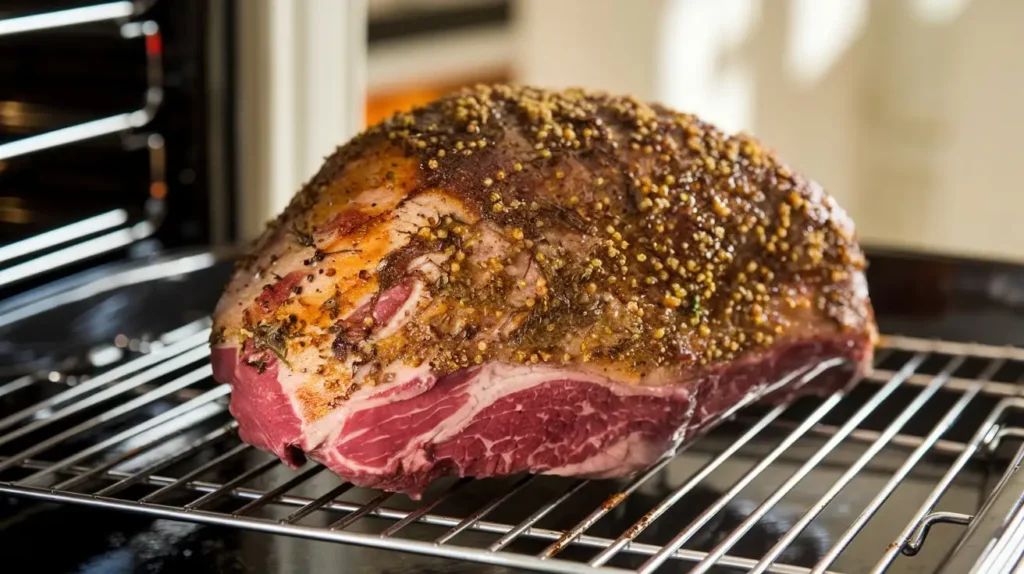
What is a Bottom Round Roast?
- Explanation of the cut:
- The bottom round roast is a flavorful cut of beef sourced from the hindquarters of the cow, specifically the outer part of the rear leg. This part of the animal is heavily exercised, which gives the meat its firm texture and leanness.
- Characteristics:
Lean: The bottom round roast has minimal fat content, making it a healthier option compared to more marbled cuts.
Tough: Due to the muscles being well-developed, the meat is naturally tougher than cuts like ribeye or tenderloin.
Flavorful: While it lacks the marbling of fattier cuts, the bottom round roast has a deep, rich beef flavor that shines when cooked properly.
This combination of leanness, toughness, and flavor makes it a fantastic choice for slow cooking or other tenderizing methods that unlock its full potential.
- The bottom round roast is an economical choice due to its origin from a tougher, less tender part of the cow, making it ideal for slow cooking methods that enhance its flavor and tenderness.Despite this, it’s incredibly versatile, working well in slow cooking, roasting, or braising methods to create tender, flavorful meals. Its adaptability also makes it perfect for leftovers, like sandwiches or soups, making it a great value for your money.
3. To make the bottom round roast tender and juicy, it’s important to use slow, moisture-retaining cooking techniques. Here are the best methods:
- Slow Cooking: Cooking the roast on low heat in a slow cooker for 6-8 hours allows the tough fibers to break down.
- Roasting: Roasting the meat at a low temperature (around 325°F) ensures even cooking and helps retain moisture. Searing the roast beforehand adds extra flavor.
- Braising: Cooking the roast in a flavorful liquid, such as beef broth or red wine, in a Dutch oven or covered pan locks in moisture while tenderizing the meat.
These methods are ideal for transforming this lean cut into a deliciously tender dish.
Essential Ingredients for the Perfect Bottom Round Roast
- List of ingredients:
| Ingredient | Amount | Description |
| Bottom round roast | 3-4 lbs | A lean, flavorful cut of beef from the hindquarters of the cow, perfect for slow cooking or roasting. |
| Olive oil | 2-3 tbsp | Used for searing the roast to develop a rich, flavorful crust. |
| Garlic | 3-4 cloves, minced | Adds aromatic depth to the roast, infusing flavor. |
| Beef broth | 1 cup | Helps keep the roast moist and tender, adding a savory base for braising or roasting. |
| Salt | To taste | Enhances the flavor of the beef, ensuring a balanced seasoning. |
| Pepper | To taste | Adds a mild heat and complements the richness of the roast. |
| Fresh rosemary | 1-2 sprigs | A fragrant herb that pairs well with beef, adding a woodsy, aromatic flavor. |
| Fresh thyme | 1-2 sprigs | Herb with subtle earthy flavor that enhances the roast’s taste. |
| Optional: | ||
| Worcestershire sauce | 1-2 tbsp | Adds a tangy, savory depth to the roast, perfect for marinades or drizzling. |
| Red wine | 1/2 cup | Enhances flavor and helps tenderize the meat with its acidity. |
| Balsamic vinegar | 1-2 tbsp | Adds a slight sweetness and acidity, balancing the savory beef flavor. |
- Ingredient tips:
Choosing the Best Bottom Round Roast
- Look for lean meat: When choosing a bottom round roast, select one that is deep red with minimal visible fat. The leaner the roast, the better it will absorb flavors from slow cooking or braising.
- Check the grade: Choose a roast with a good marbling of fat, as it will ensure moisture and flavor during cooking. USDA Choice or Prime grades are ideal, though Select grade is still a budget-friendly option.
- Freshness: Ensure the roast is fresh, not frozen, for optimal tenderness and flavor. If buying from a butcher, ask about its origin and freshness.
Using Fresh Herbs vs. Dried Herbs
- Fresh Herbs:
- Flavor: Fresh herbs like rosemary and thyme offer a more vibrant, aromatic flavor compared to dried.
- Usage: Incorporate fresh herbs at the end of cooking for a burst of fresh flavor, or add them earlier for a more delicate, infused taste throughout the dish.
- Quantity: You’ll need about 3 times more fresh herbs than dried to achieve the same flavor.
- Dried Herbs:
- Flavor: Dried herbs are more concentrated and have a slightly different flavor profile. They are perfect for longer cooking methods like roasting and braising, as they have time to release their oils into the dish.
- Usage: Add dried herbs early in the cooking process to allow their flavors to fully develop.
- Storage: Dried herbs have a longer shelf life and are great to keep on hand in your pantry.
Both fresh and dried herbs can work well, but the choice depends on the cooking time and the desired intensity of flavor!
3. Marinating your bottom round roast can elevate its flavor, adding depth and moisture. Here are a few delicious options to try:
1. Garlic and Herb Marinade
- Ingredients: Olive oil, minced garlic, fresh rosemary, thyme, salt, pepper, lemon juice
- Why it works: The garlic adds aromatic richness, while the fresh herbs infuse the roast with a classic, savory flavor. The lemon juice helps tenderize the meat while balancing the flavors.
2. Balsamic Vinegar and Honey Marinade
- Ingredients: Balsamic vinegar, honey, olive oil, Dijon mustard, fresh thyme, salt, pepper
- Why it works: The balsamic vinegar offers tanginess and depth, while the honey adds a subtle sweetness that balances the beefy flavor. Mustard provides a slight kick, rounding out the taste.
3. Red Wine and Worcestershire Marinade
- Ingredients: Red wine, Worcestershire sauce, garlic, fresh rosemary, salt, pepper
- Why it works: Red wine helps tenderize the roast, while Worcestershire sauce adds umami richness. The garlic and rosemary add depth, making this marinade perfect for a full-flavored roast.
4. Soy Sauce and Brown Sugar Marinade
- Ingredients: Soy sauce, brown sugar, garlic, ginger, sesame oil, green onions
- Why it works: This marinade provides a sweet and salty balance, with the soy sauce deepening the beef’s natural flavors. The addition of ginger and sesame oil gives it an Asian-inspired flair.
5. Mustard and Herb Marinade
- Ingredients: Dijon mustard, olive oil, garlic, fresh parsley, rosemary, salt, pepper
- Why it works: The mustard gives the roast a tangy and slightly spicy kick, which pairs beautifully with the herbs.This marinade is straightforward yet imparts a distinct and flavorful twist to your roast.
4. Marinating Tips:
- Marinate the roast for at least 2 hours, but overnight in the fridge will allow the flavors to fully infuse the meat.
- Remember to bring the roast to room temperature before cooking for more even cooking results.
These marinades offer variety and can enhance your bottom round roast in different ways depending on your flavor preferences.
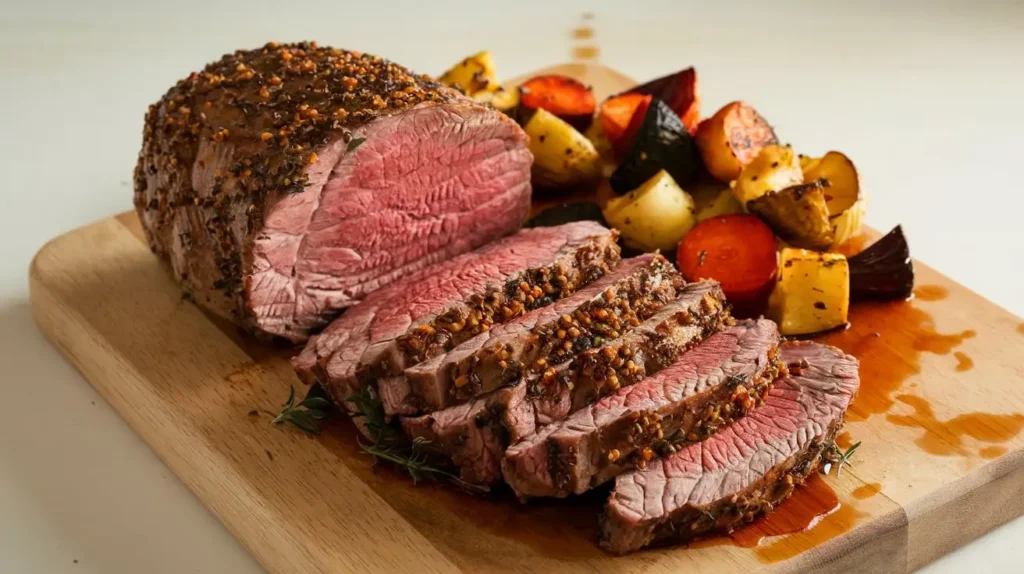
Step-by-Step Instructions to Cook Bottom Round Roast
- Preparation:
Trim the Fat if Necessary
- Why it’s important: While some fat adds flavor and moisture, too much can cause the roast to be greasy and make it harder to achieve a tender, juicy roast. Trim off any thick layers of fat, but leave a thin layer to help keep the roast moist during cooking.
- How to do it: Use a sharp knife to carefully remove any large patches of fat, particularly on the edges of the roast. Be mindful not to remove all of the fat, as it can enhance the flavor and tenderness.
Season the Roast Generously
- Why it’s important: A well-seasoned roast is key to developing rich, deep flavor. Don’t skimp on the seasoning!
- How to do it:
- Salt & Pepper: Start with a generous amount of salt and freshly ground black pepper, Coating the entire surface of the roast with the rub. This helps create a flavorful crust when seared.
- Additional Seasonings: For extra flavor, add minced garlic, fresh or dried herbs (like rosemary, thyme), and any other seasonings you prefer (e.g., onion powder, paprika).
- Marinating Option: If you’re marinating your roast (as discussed earlier), ensure the roast is fully coated with the marinade before refrigerating for the suggested duration.
Proper preparation ensures that your roast is flavorful and ready for the next steps in cooking.
- Searing:
Why Searing is Important:
Searing the roast develops a golden, flavorful crust that seals in juices and elevates the beef’s natural richness. It also helps to develop rich, caramelized flavors that will elevate your roast.
How to Sear the Roast:
- Heat the Skillet:
- Place a heavy skillet (preferably cast iron) on the stovetop over medium-high heat.
- Add 2-3 tablespoons of olive oil and allow it to heat until it shimmers but isn’t smoking.
- Sear the Roast:
- Once the oil is hot, carefully place the seasoned bottom round roast in the skillet.
- Sear the roast on all sides, turning it occasionally with tongs, to achieve a golden-brown crust.
- Ensure that all sides are evenly seared for maximum flavor and texture.
- Rest Before Cooking:
- Once you’ve finished searing, set the roast aside and let it rest for a few minutes to retain its juices before transferring it to the oven, slow cooker, or Dutch oven for the next stage of cooking.
By searing the roast, you’re adding an extra layer of flavor that will carry through the rest of the cooking process!
- Cooking Options:
1. Oven Method:
- Temperature: Preheat your oven to 325°F.
- Cooking Time: Roast the bottom round roast for 1.5 to 2 hours, or until the internal temperature reaches 135°F for medium-rare. For medium or well-done, cook longer, checking the temperature with a meat thermometer.
- Steps:
- Once seared, move the roast to a roasting pan and place it in the preheated oven.
- Roast the meat until it reaches the preferred internal temperature.
- After roasting, take the roast out of the oven and let it rest for 10-15 minutes before slicing to ensure the juices settle.
- Once seared, transfer the roast to a roasting pan and place it in the preheated oven.
- Roast until it reaches your preferred internal temperature, then take it out of the oven and let it rest for 10-15 minutes before slicing.
2. Slow Cooker Method:
- Temperature: Set your slow cooker to low.
- Cooking Time: Cook for 6-8 hours for tender, pull-apart beef.
- Steps:
- Once seared, place the roast in the slow cooker to continue cooking.
- Add beef broth, and optionally vegetables like carrots, onions, and potatoes for added flavor.
- Cover and cook on low until the roast reaches the desired tenderness.
- Once cooked, let the roast rest before slicing or shredding.
3. Dutch Oven Method (Braising):
- Temperature: Preheat your oven to 300°F.
- Cooking Time: Braise for 2-3 hours until the roast is tender.
- Steps:
- After searing, place the roast into a Dutch oven and add beef broth (enough to cover the bottom of the roast).
- Place the lid on and place the roast in the preheated oven to cook.
- Let it braise for 2-3 hours, checking for tenderness.
- Once done, remove the roast from the oven, rest it, then slice.
These methods ensure your bottom round roast becomes juicy and tender, whether you prefer slow cooking, oven roasting, or braising in a Dutch oven.
- Resting and Carving:
Rest the Roast:
- Why it’s important: Resting the roast after cooking allows the juices to redistribute throughout the meat, making it more flavorful and tender. If you carve immediately, the juices will escape, resulting in a drier roast.
- How to do it:
- After removing the roast from the oven, slow cooker, or Dutch oven, tent it loosely with aluminum foil.
- Let it rest for 10-15 minutes to allow the meat to settle and retain its moisture.
Carve the Roast:
- Why it’s important: Slicing the roast correctly is key to ensuring maximum tenderness and a great eating experience.
- How to do it:
- Slice thinly against the grain: Look for the lines (or “grain”) running through the meat and slice against them. This helps break down the muscle fibers, making the roast more tender and easier to enjoy.
- Use a sharp carving knife to make clean, even slices, ensuring the meat stays tender and juicy.
Resting and slicing against the grain are crucial steps in turning your bottom round roast into a melt-in-your-mouth experience!
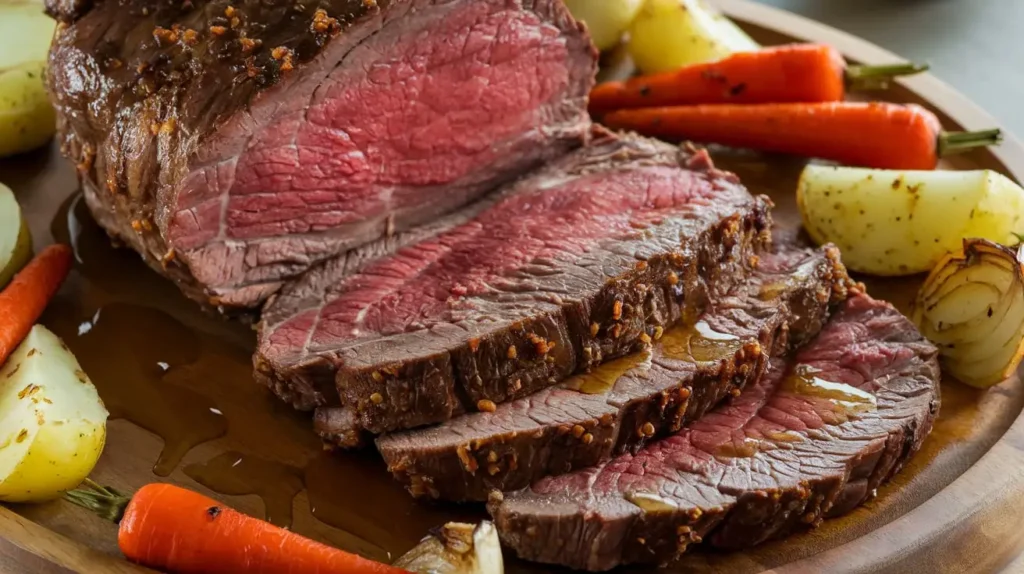
Tips for a Juicy and Tender Bottom Round Roast
- Use a Meat Thermometer:
- Why it helps: A meat thermometer ensures you cook the roast to your desired level of doneness without overcooking.
- Tip: Insert the thermometer into the thickest part of the roast for an accurate reading.
- Cook Low and Slow:
- Why it helps: Cooking the roast at a low temperature for a longer time breaks down the tough fibers, resulting in a more tender roast.
- Tip: Whether using the oven, slow cooker, or Dutch oven, avoid rushing the cooking process—let the heat work its magic on the meat over several hours.
- Let the Meat Rest Before Carving:
- Why it helps: Resting allows the juices to redistribute throughout the roast, keeping it moist and flavorful.
- Tip: Cover the roast loosely with foil and let it rest for 10-15 minutes before slicing.
- Slice Against the Grain:
- Why it helps: Slicing against the grain shortens the muscle fibers, resulting in a more tender texture and making the meat easier to chew.
- Tip: Look for the direction of the fibers (grain) and slice across them to get the best texture.
Following these tips will ensure your bottom round roast turns out tender, juicy, and full of flavor!
Delicious Serving Suggestions and Pairings
Pair with Classic Sides:
- Mashed Potatoes: The creamy texture of mashed potatoes complements the hearty flavors of the roast, making for a comforting classic pairing.
- Roasted Carrots: Roasted carrots add a sweet, caramelized crunch that balances the savory beef.
- Green Beans: Lightly sautéed or roasted green beans provide a fresh, crisp contrast to the rich roast.
Add a Sauce:
- Gravy Made from Pan Drippings: Use the flavorful drippings from your roast to create a savory gravy that enhances the beef’s natural juices.
- Horseradish Cream: The cool, tangy kick of horseradish cream pairs perfectly with the richness of the beef, adding a bit of zest to each bite.
- Chimichurri: For a fresh, herby contrast, drizzle chimichurri sauce (a blend of parsley, garlic, vinegar, and oil) over the roast for a punch of flavor.
Storage and Leftovers:
- Tips for Reheating Without Drying Out:
- Reheat gently: To keep the roast moist, reheat it in a covered dish in the oven at a low temperature (around 300°F) for 10-15 minutes, or in a slow cooker on low with a bit of broth.
- Avoid overcooking: Heat just until warmed through to preserve tenderness and juiciness.
- Use Leftovers for Sandwiches or Beef Stew:
- Sandwiches: Thinly slice the leftover roast and pile it on fresh bread with horseradish sauce or mustard for a delicious sandwich.
- Beef Stew: Cube the leftover roast and use it in a hearty beef stew with vegetables and broth for a comforting second meal.
These pairings and leftover ideas will take your bottom round roast from a delicious main course to a well-rounded, satisfying meal!
Conclusion:
- This Bottom Round Roast Recipe is simple yet incredibly flavorful, offering a tender, juicy roast with minimal effort. Whether you choose to roast it in the oven, slow cook it, or braise it in a Dutch oven, this recipe ensures a melt-in-your-mouth result every time. By following easy steps like searing the roast, seasoning generously, and using low and slow cooking methods, you’ll create a roast that’s perfect for any occasion.
- We hope you give this recipe a try and experience the delicious results! Don’t forget to share this recipe with friends or leave a comment below with your favorite way to prepare a bottom round roast.
FAQ:
- Q: How do I cook a bottom round roast in a slow cooker?
A: Sear the roast, then cook it on low for 6-8 hours in the slow cooker with seasonings and liquids. - Q: What is the easiest way to prepare a bottom round roast?
A: Season, roast at 325°F for 1.5-2 hours, and let it rest before slicing. - Q: How do I cook a bottom round roast in the oven?
A: Sear the roast, then roast at 325°F for 1.5-2 hours. - Q: How does Pioneer Woman cook a bottom round roast?
A: Season, brown in a Dutch oven, and slow-roast with vegetables in the oven. - Q: Why should I cook a bottom round roast low and slow?
A: It breaks down the muscle fibers for a tender, juicy roast. - Q: What is the best recipe for bottom round roast?
A: Season with garlic, herbs, and broth, then cook low and slow for the best results. - Q: How do I cook a bottom round roast in a Dutch oven?
A: Sear, add broth and herbs, cover, and cook at 325°F for 2-3 hours. - Q: How long should I cook a bottom round roast at 325°F?
A: Cook for 1.5-2 hours or until it reaches 135°F for medium-rare.
There are no reviews yet. Be the first one to write one.

